Comparative Study of Buddhism and Christianity Religions
VerifiedAdded on 2021/12/15
|10
|3416
|165
Essay
AI Summary
This essay undertakes a comparative analysis of Buddhism and Christianity, focusing on the lives and teachings of Lord Buddha and Jesus Christ. It examines the core principles of both religions, including the concept of the "Noble Eightfold Path" in Buddhism and the emphasis on repentance and purity in Christianity. The essay highlights the historical context, key figures, and the evolution of both religions, including the emergence of different sects within each. It also explores the impact of these religions on inter-religious practices and their relevance in contemporary society, emphasizing the role of both Buddhism and Christianity in providing mental peace and emotional solace to individuals. The essay draws on various scholarly sources to support its arguments and provide a comprehensive overview of the two religions.
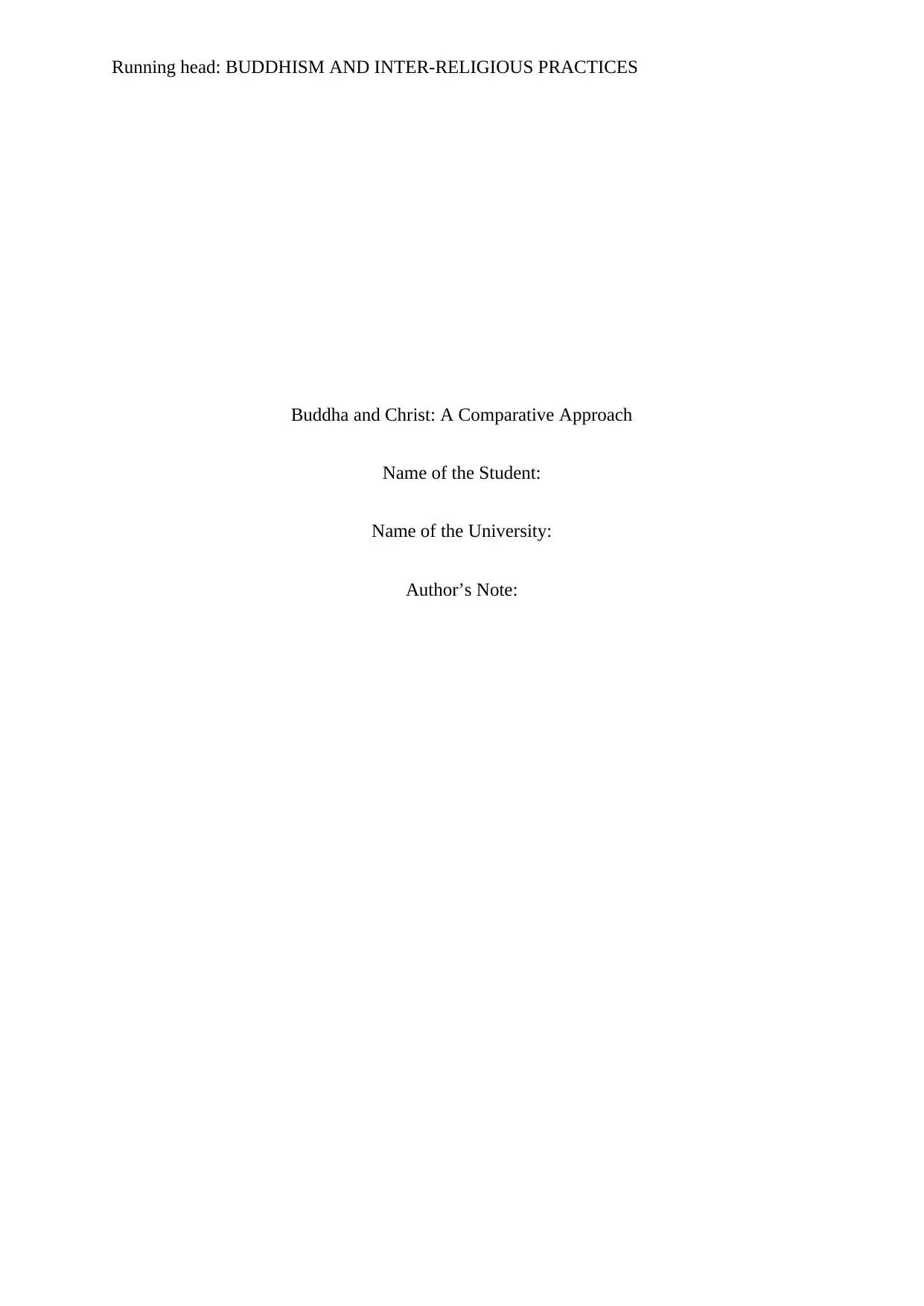
Running head: BUDDHISM AND INTER-RELIGIOUS PRACTICES
Buddha and Christ: A Comparative Approach
Name of the Student:
Name of the University:
Author’s Note:
Buddha and Christ: A Comparative Approach
Name of the Student:
Name of the University:
Author’s Note:
Paraphrase This Document
Need a fresh take? Get an instant paraphrase of this document with our AI Paraphraser
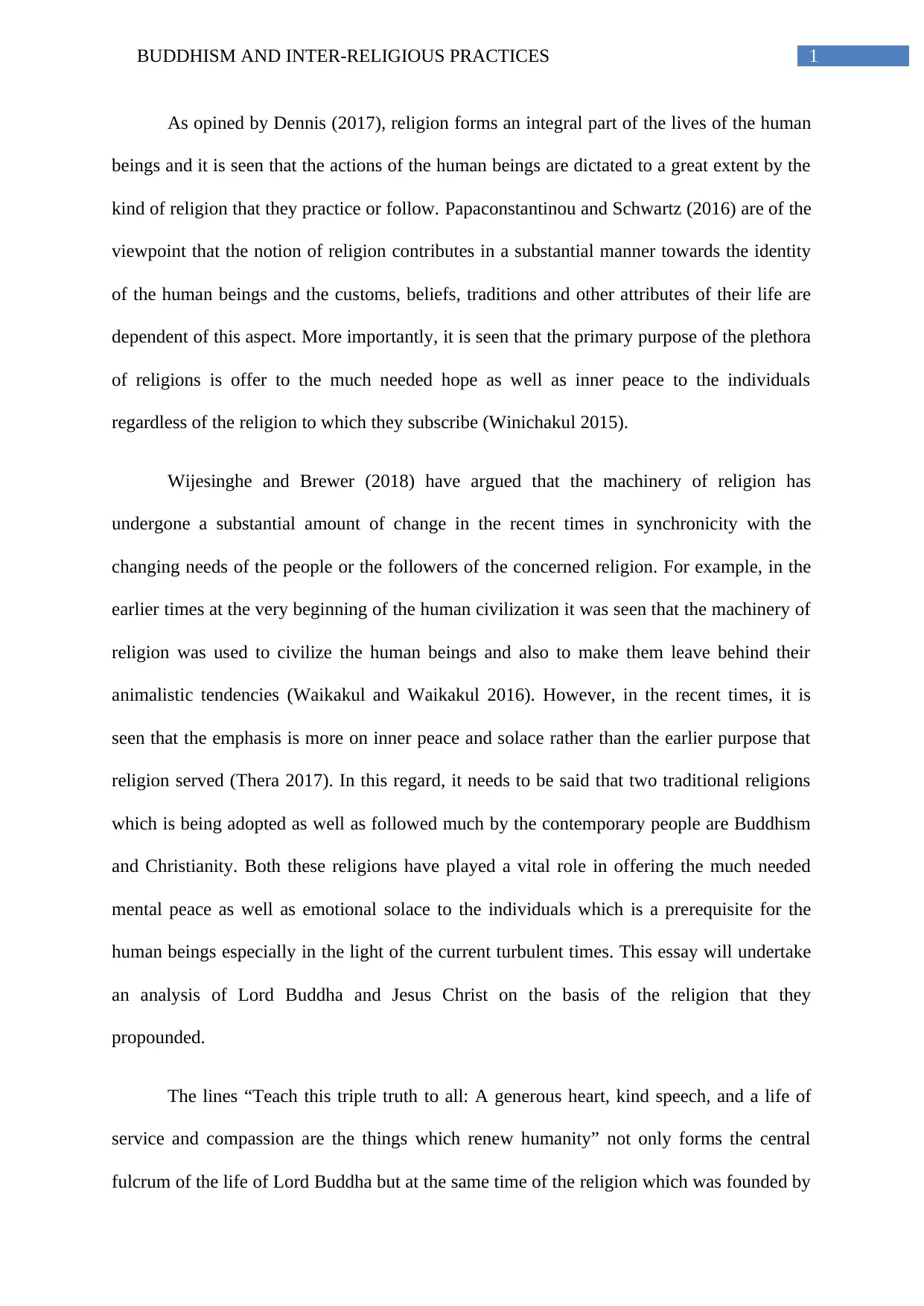
1BUDDHISM AND INTER-RELIGIOUS PRACTICES
As opined by Dennis (2017), religion forms an integral part of the lives of the human
beings and it is seen that the actions of the human beings are dictated to a great extent by the
kind of religion that they practice or follow. Papaconstantinou and Schwartz (2016) are of the
viewpoint that the notion of religion contributes in a substantial manner towards the identity
of the human beings and the customs, beliefs, traditions and other attributes of their life are
dependent of this aspect. More importantly, it is seen that the primary purpose of the plethora
of religions is offer to the much needed hope as well as inner peace to the individuals
regardless of the religion to which they subscribe (Winichakul 2015).
Wijesinghe and Brewer (2018) have argued that the machinery of religion has
undergone a substantial amount of change in the recent times in synchronicity with the
changing needs of the people or the followers of the concerned religion. For example, in the
earlier times at the very beginning of the human civilization it was seen that the machinery of
religion was used to civilize the human beings and also to make them leave behind their
animalistic tendencies (Waikakul and Waikakul 2016). However, in the recent times, it is
seen that the emphasis is more on inner peace and solace rather than the earlier purpose that
religion served (Thera 2017). In this regard, it needs to be said that two traditional religions
which is being adopted as well as followed much by the contemporary people are Buddhism
and Christianity. Both these religions have played a vital role in offering the much needed
mental peace as well as emotional solace to the individuals which is a prerequisite for the
human beings especially in the light of the current turbulent times. This essay will undertake
an analysis of Lord Buddha and Jesus Christ on the basis of the religion that they
propounded.
The lines “Teach this triple truth to all: A generous heart, kind speech, and a life of
service and compassion are the things which renew humanity” not only forms the central
fulcrum of the life of Lord Buddha but at the same time of the religion which was founded by
As opined by Dennis (2017), religion forms an integral part of the lives of the human
beings and it is seen that the actions of the human beings are dictated to a great extent by the
kind of religion that they practice or follow. Papaconstantinou and Schwartz (2016) are of the
viewpoint that the notion of religion contributes in a substantial manner towards the identity
of the human beings and the customs, beliefs, traditions and other attributes of their life are
dependent of this aspect. More importantly, it is seen that the primary purpose of the plethora
of religions is offer to the much needed hope as well as inner peace to the individuals
regardless of the religion to which they subscribe (Winichakul 2015).
Wijesinghe and Brewer (2018) have argued that the machinery of religion has
undergone a substantial amount of change in the recent times in synchronicity with the
changing needs of the people or the followers of the concerned religion. For example, in the
earlier times at the very beginning of the human civilization it was seen that the machinery of
religion was used to civilize the human beings and also to make them leave behind their
animalistic tendencies (Waikakul and Waikakul 2016). However, in the recent times, it is
seen that the emphasis is more on inner peace and solace rather than the earlier purpose that
religion served (Thera 2017). In this regard, it needs to be said that two traditional religions
which is being adopted as well as followed much by the contemporary people are Buddhism
and Christianity. Both these religions have played a vital role in offering the much needed
mental peace as well as emotional solace to the individuals which is a prerequisite for the
human beings especially in the light of the current turbulent times. This essay will undertake
an analysis of Lord Buddha and Jesus Christ on the basis of the religion that they
propounded.
The lines “Teach this triple truth to all: A generous heart, kind speech, and a life of
service and compassion are the things which renew humanity” not only forms the central
fulcrum of the life of Lord Buddha but at the same time of the religion which was founded by
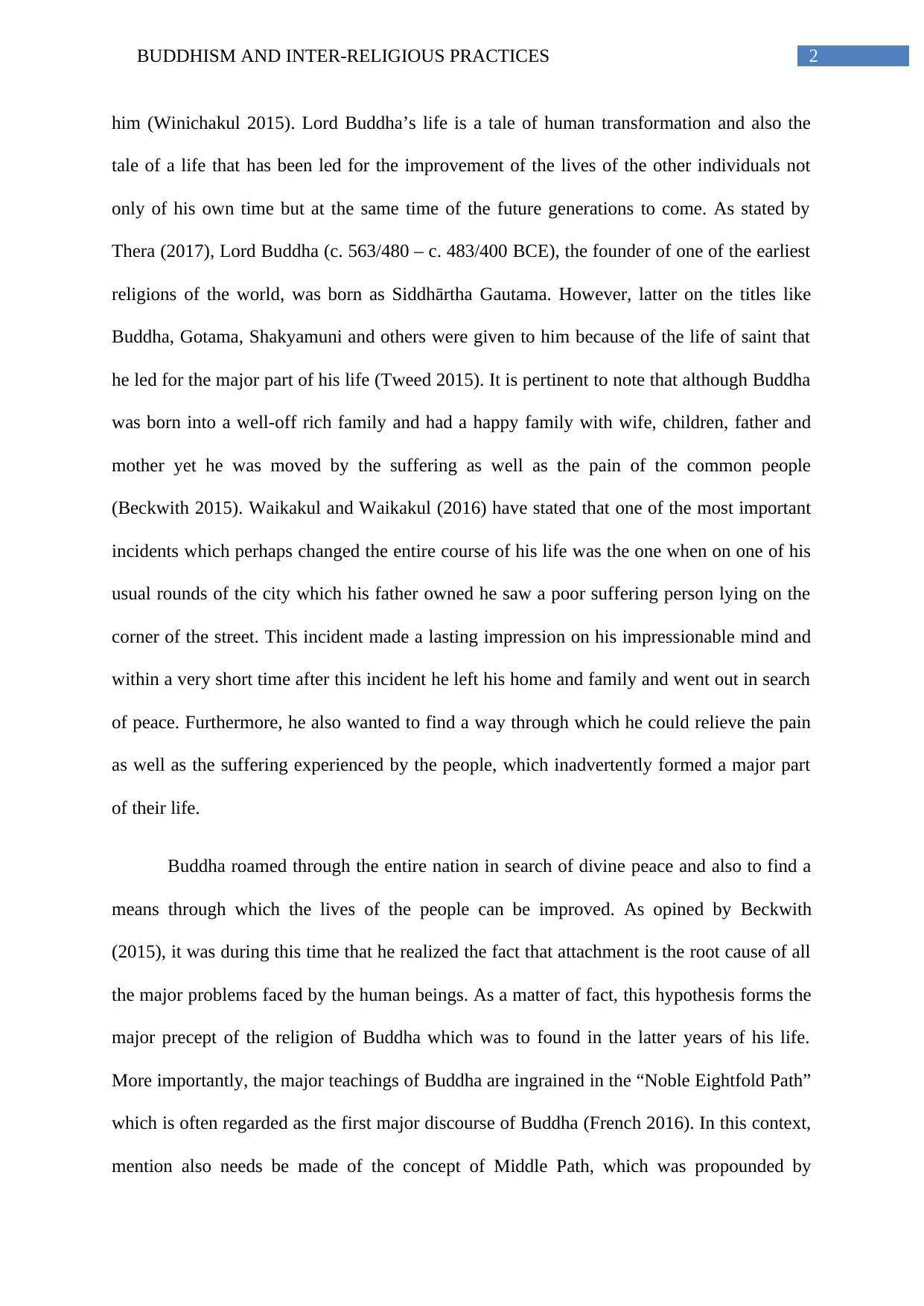
2BUDDHISM AND INTER-RELIGIOUS PRACTICES
him (Winichakul 2015). Lord Buddha’s life is a tale of human transformation and also the
tale of a life that has been led for the improvement of the lives of the other individuals not
only of his own time but at the same time of the future generations to come. As stated by
Thera (2017), Lord Buddha (c. 563/480 – c. 483/400 BCE), the founder of one of the earliest
religions of the world, was born as Siddhārtha Gautama. However, latter on the titles like
Buddha, Gotama, Shakyamuni and others were given to him because of the life of saint that
he led for the major part of his life (Tweed 2015). It is pertinent to note that although Buddha
was born into a well-off rich family and had a happy family with wife, children, father and
mother yet he was moved by the suffering as well as the pain of the common people
(Beckwith 2015). Waikakul and Waikakul (2016) have stated that one of the most important
incidents which perhaps changed the entire course of his life was the one when on one of his
usual rounds of the city which his father owned he saw a poor suffering person lying on the
corner of the street. This incident made a lasting impression on his impressionable mind and
within a very short time after this incident he left his home and family and went out in search
of peace. Furthermore, he also wanted to find a way through which he could relieve the pain
as well as the suffering experienced by the people, which inadvertently formed a major part
of their life.
Buddha roamed through the entire nation in search of divine peace and also to find a
means through which the lives of the people can be improved. As opined by Beckwith
(2015), it was during this time that he realized the fact that attachment is the root cause of all
the major problems faced by the human beings. As a matter of fact, this hypothesis forms the
major precept of the religion of Buddha which was to found in the latter years of his life.
More importantly, the major teachings of Buddha are ingrained in the “Noble Eightfold Path”
which is often regarded as the first major discourse of Buddha (French 2016). In this context,
mention also needs be made of the concept of Middle Path, which was propounded by
him (Winichakul 2015). Lord Buddha’s life is a tale of human transformation and also the
tale of a life that has been led for the improvement of the lives of the other individuals not
only of his own time but at the same time of the future generations to come. As stated by
Thera (2017), Lord Buddha (c. 563/480 – c. 483/400 BCE), the founder of one of the earliest
religions of the world, was born as Siddhārtha Gautama. However, latter on the titles like
Buddha, Gotama, Shakyamuni and others were given to him because of the life of saint that
he led for the major part of his life (Tweed 2015). It is pertinent to note that although Buddha
was born into a well-off rich family and had a happy family with wife, children, father and
mother yet he was moved by the suffering as well as the pain of the common people
(Beckwith 2015). Waikakul and Waikakul (2016) have stated that one of the most important
incidents which perhaps changed the entire course of his life was the one when on one of his
usual rounds of the city which his father owned he saw a poor suffering person lying on the
corner of the street. This incident made a lasting impression on his impressionable mind and
within a very short time after this incident he left his home and family and went out in search
of peace. Furthermore, he also wanted to find a way through which he could relieve the pain
as well as the suffering experienced by the people, which inadvertently formed a major part
of their life.
Buddha roamed through the entire nation in search of divine peace and also to find a
means through which the lives of the people can be improved. As opined by Beckwith
(2015), it was during this time that he realized the fact that attachment is the root cause of all
the major problems faced by the human beings. As a matter of fact, this hypothesis forms the
major precept of the religion of Buddha which was to found in the latter years of his life.
More importantly, the major teachings of Buddha are ingrained in the “Noble Eightfold Path”
which is often regarded as the first major discourse of Buddha (French 2016). In this context,
mention also needs be made of the concept of Middle Path, which was propounded by
⊘ This is a preview!⊘
Do you want full access?
Subscribe today to unlock all pages.

Trusted by 1+ million students worldwide
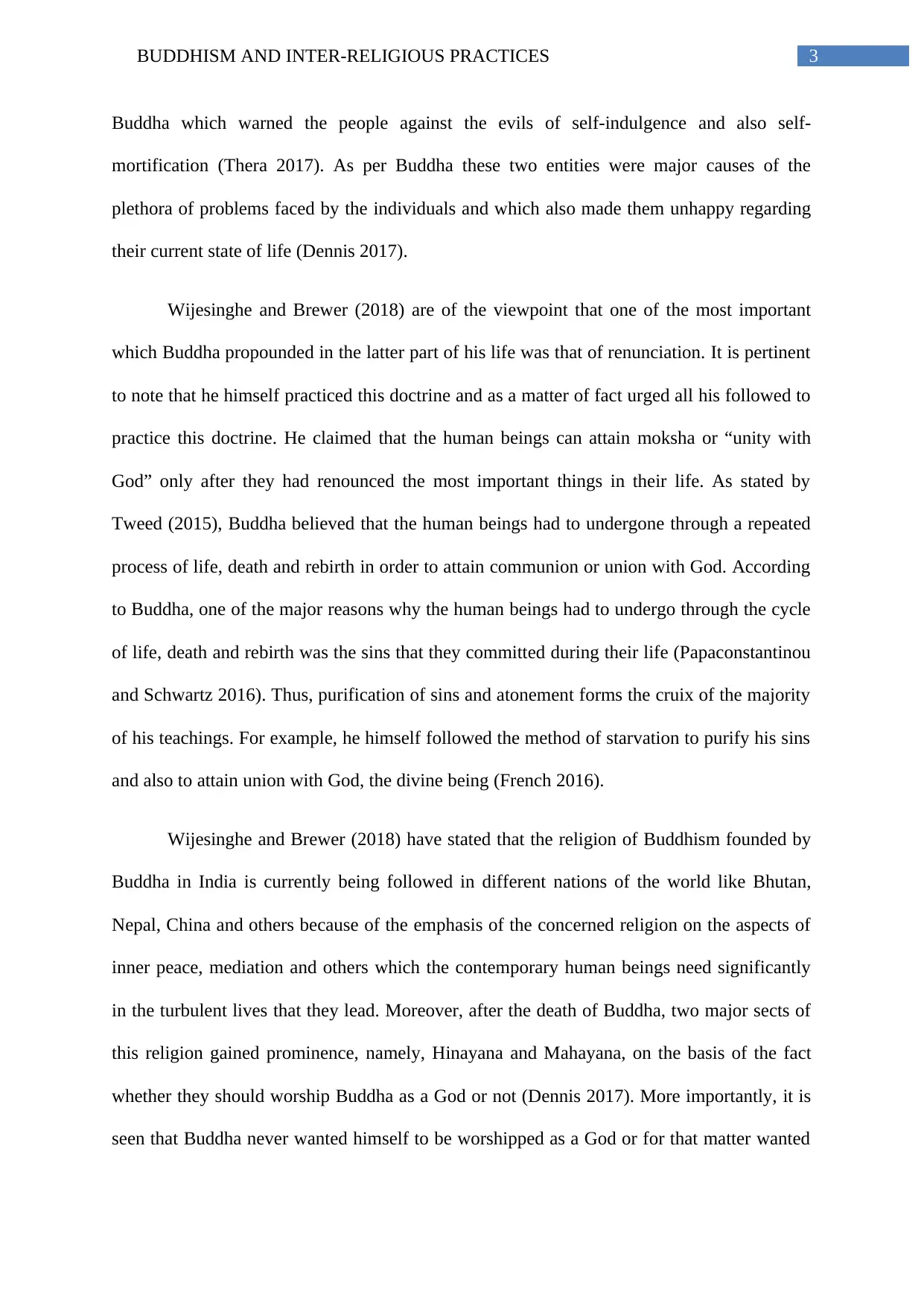
3BUDDHISM AND INTER-RELIGIOUS PRACTICES
Buddha which warned the people against the evils of self-indulgence and also self-
mortification (Thera 2017). As per Buddha these two entities were major causes of the
plethora of problems faced by the individuals and which also made them unhappy regarding
their current state of life (Dennis 2017).
Wijesinghe and Brewer (2018) are of the viewpoint that one of the most important
which Buddha propounded in the latter part of his life was that of renunciation. It is pertinent
to note that he himself practiced this doctrine and as a matter of fact urged all his followed to
practice this doctrine. He claimed that the human beings can attain moksha or “unity with
God” only after they had renounced the most important things in their life. As stated by
Tweed (2015), Buddha believed that the human beings had to undergone through a repeated
process of life, death and rebirth in order to attain communion or union with God. According
to Buddha, one of the major reasons why the human beings had to undergo through the cycle
of life, death and rebirth was the sins that they committed during their life (Papaconstantinou
and Schwartz 2016). Thus, purification of sins and atonement forms the cruix of the majority
of his teachings. For example, he himself followed the method of starvation to purify his sins
and also to attain union with God, the divine being (French 2016).
Wijesinghe and Brewer (2018) have stated that the religion of Buddhism founded by
Buddha in India is currently being followed in different nations of the world like Bhutan,
Nepal, China and others because of the emphasis of the concerned religion on the aspects of
inner peace, mediation and others which the contemporary human beings need significantly
in the turbulent lives that they lead. Moreover, after the death of Buddha, two major sects of
this religion gained prominence, namely, Hinayana and Mahayana, on the basis of the fact
whether they should worship Buddha as a God or not (Dennis 2017). More importantly, it is
seen that Buddha never wanted himself to be worshipped as a God or for that matter wanted
Buddha which warned the people against the evils of self-indulgence and also self-
mortification (Thera 2017). As per Buddha these two entities were major causes of the
plethora of problems faced by the individuals and which also made them unhappy regarding
their current state of life (Dennis 2017).
Wijesinghe and Brewer (2018) are of the viewpoint that one of the most important
which Buddha propounded in the latter part of his life was that of renunciation. It is pertinent
to note that he himself practiced this doctrine and as a matter of fact urged all his followed to
practice this doctrine. He claimed that the human beings can attain moksha or “unity with
God” only after they had renounced the most important things in their life. As stated by
Tweed (2015), Buddha believed that the human beings had to undergone through a repeated
process of life, death and rebirth in order to attain communion or union with God. According
to Buddha, one of the major reasons why the human beings had to undergo through the cycle
of life, death and rebirth was the sins that they committed during their life (Papaconstantinou
and Schwartz 2016). Thus, purification of sins and atonement forms the cruix of the majority
of his teachings. For example, he himself followed the method of starvation to purify his sins
and also to attain union with God, the divine being (French 2016).
Wijesinghe and Brewer (2018) have stated that the religion of Buddhism founded by
Buddha in India is currently being followed in different nations of the world like Bhutan,
Nepal, China and others because of the emphasis of the concerned religion on the aspects of
inner peace, mediation and others which the contemporary human beings need significantly
in the turbulent lives that they lead. Moreover, after the death of Buddha, two major sects of
this religion gained prominence, namely, Hinayana and Mahayana, on the basis of the fact
whether they should worship Buddha as a God or not (Dennis 2017). More importantly, it is
seen that Buddha never wanted himself to be worshipped as a God or for that matter wanted
Paraphrase This Document
Need a fresh take? Get an instant paraphrase of this document with our AI Paraphraser
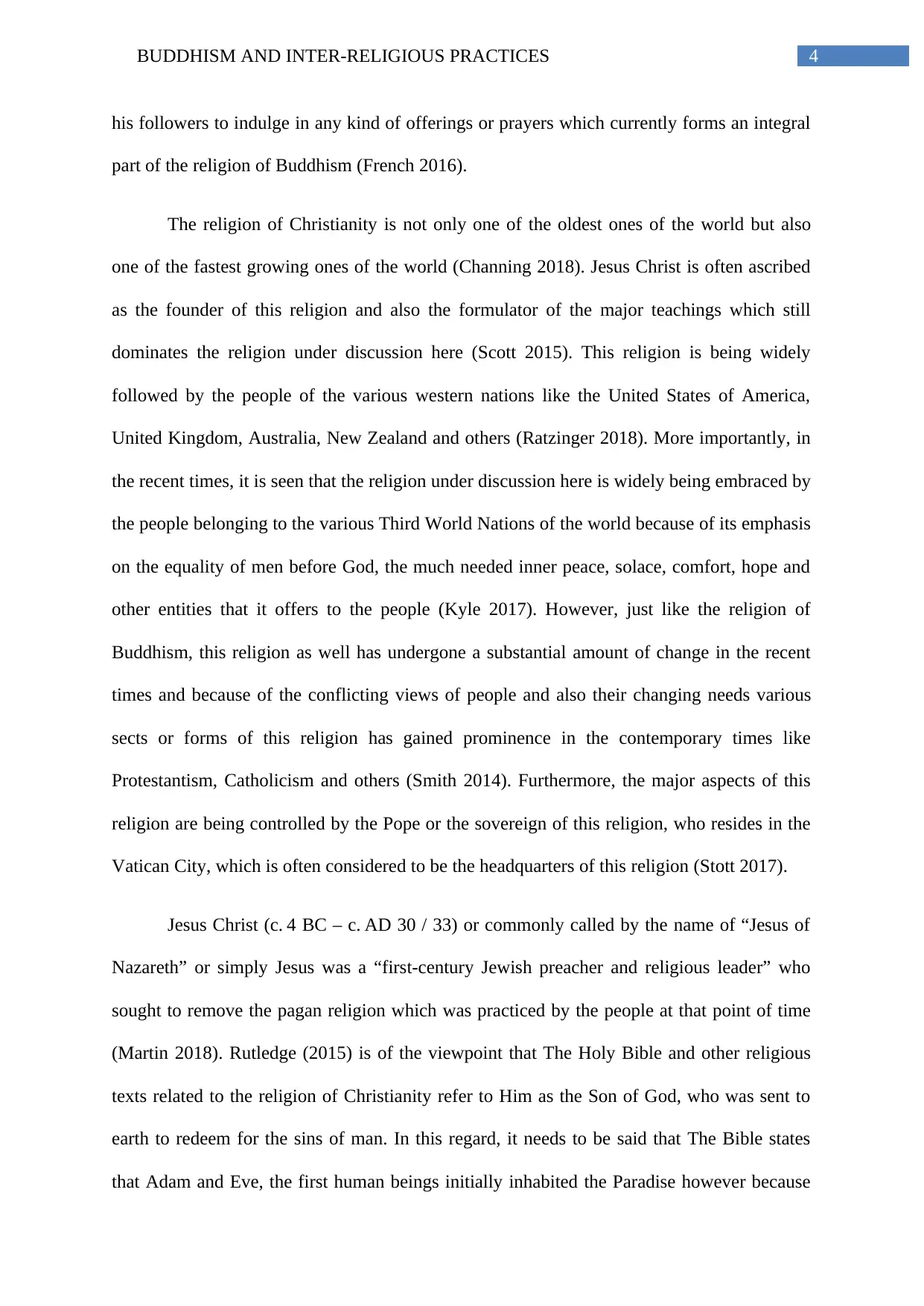
4BUDDHISM AND INTER-RELIGIOUS PRACTICES
his followers to indulge in any kind of offerings or prayers which currently forms an integral
part of the religion of Buddhism (French 2016).
The religion of Christianity is not only one of the oldest ones of the world but also
one of the fastest growing ones of the world (Channing 2018). Jesus Christ is often ascribed
as the founder of this religion and also the formulator of the major teachings which still
dominates the religion under discussion here (Scott 2015). This religion is being widely
followed by the people of the various western nations like the United States of America,
United Kingdom, Australia, New Zealand and others (Ratzinger 2018). More importantly, in
the recent times, it is seen that the religion under discussion here is widely being embraced by
the people belonging to the various Third World Nations of the world because of its emphasis
on the equality of men before God, the much needed inner peace, solace, comfort, hope and
other entities that it offers to the people (Kyle 2017). However, just like the religion of
Buddhism, this religion as well has undergone a substantial amount of change in the recent
times and because of the conflicting views of people and also their changing needs various
sects or forms of this religion has gained prominence in the contemporary times like
Protestantism, Catholicism and others (Smith 2014). Furthermore, the major aspects of this
religion are being controlled by the Pope or the sovereign of this religion, who resides in the
Vatican City, which is often considered to be the headquarters of this religion (Stott 2017).
Jesus Christ (c. 4 BC – c. AD 30 / 33) or commonly called by the name of “Jesus of
Nazareth” or simply Jesus was a “first-century Jewish preacher and religious leader” who
sought to remove the pagan religion which was practiced by the people at that point of time
(Martin 2018). Rutledge (2015) is of the viewpoint that The Holy Bible and other religious
texts related to the religion of Christianity refer to Him as the Son of God, who was sent to
earth to redeem for the sins of man. In this regard, it needs to be said that The Bible states
that Adam and Eve, the first human beings initially inhabited the Paradise however because
his followers to indulge in any kind of offerings or prayers which currently forms an integral
part of the religion of Buddhism (French 2016).
The religion of Christianity is not only one of the oldest ones of the world but also
one of the fastest growing ones of the world (Channing 2018). Jesus Christ is often ascribed
as the founder of this religion and also the formulator of the major teachings which still
dominates the religion under discussion here (Scott 2015). This religion is being widely
followed by the people of the various western nations like the United States of America,
United Kingdom, Australia, New Zealand and others (Ratzinger 2018). More importantly, in
the recent times, it is seen that the religion under discussion here is widely being embraced by
the people belonging to the various Third World Nations of the world because of its emphasis
on the equality of men before God, the much needed inner peace, solace, comfort, hope and
other entities that it offers to the people (Kyle 2017). However, just like the religion of
Buddhism, this religion as well has undergone a substantial amount of change in the recent
times and because of the conflicting views of people and also their changing needs various
sects or forms of this religion has gained prominence in the contemporary times like
Protestantism, Catholicism and others (Smith 2014). Furthermore, the major aspects of this
religion are being controlled by the Pope or the sovereign of this religion, who resides in the
Vatican City, which is often considered to be the headquarters of this religion (Stott 2017).
Jesus Christ (c. 4 BC – c. AD 30 / 33) or commonly called by the name of “Jesus of
Nazareth” or simply Jesus was a “first-century Jewish preacher and religious leader” who
sought to remove the pagan religion which was practiced by the people at that point of time
(Martin 2018). Rutledge (2015) is of the viewpoint that The Holy Bible and other religious
texts related to the religion of Christianity refer to Him as the Son of God, who was sent to
earth to redeem for the sins of man. In this regard, it needs to be said that The Bible states
that Adam and Eve, the first human beings initially inhabited the Paradise however because
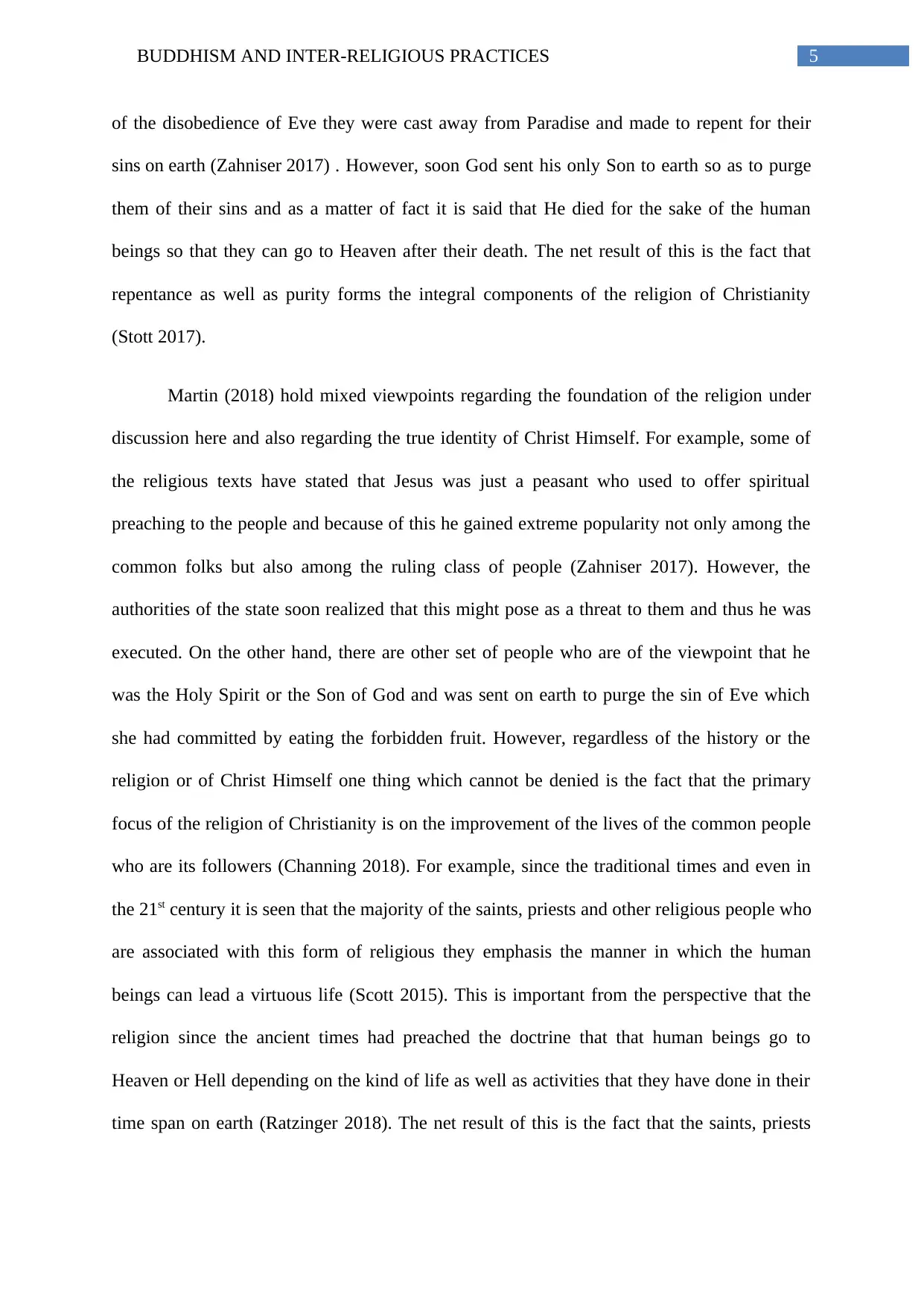
5BUDDHISM AND INTER-RELIGIOUS PRACTICES
of the disobedience of Eve they were cast away from Paradise and made to repent for their
sins on earth (Zahniser 2017) . However, soon God sent his only Son to earth so as to purge
them of their sins and as a matter of fact it is said that He died for the sake of the human
beings so that they can go to Heaven after their death. The net result of this is the fact that
repentance as well as purity forms the integral components of the religion of Christianity
(Stott 2017).
Martin (2018) hold mixed viewpoints regarding the foundation of the religion under
discussion here and also regarding the true identity of Christ Himself. For example, some of
the religious texts have stated that Jesus was just a peasant who used to offer spiritual
preaching to the people and because of this he gained extreme popularity not only among the
common folks but also among the ruling class of people (Zahniser 2017). However, the
authorities of the state soon realized that this might pose as a threat to them and thus he was
executed. On the other hand, there are other set of people who are of the viewpoint that he
was the Holy Spirit or the Son of God and was sent on earth to purge the sin of Eve which
she had committed by eating the forbidden fruit. However, regardless of the history or the
religion or of Christ Himself one thing which cannot be denied is the fact that the primary
focus of the religion of Christianity is on the improvement of the lives of the common people
who are its followers (Channing 2018). For example, since the traditional times and even in
the 21st century it is seen that the majority of the saints, priests and other religious people who
are associated with this form of religious they emphasis the manner in which the human
beings can lead a virtuous life (Scott 2015). This is important from the perspective that the
religion since the ancient times had preached the doctrine that that human beings go to
Heaven or Hell depending on the kind of life as well as activities that they have done in their
time span on earth (Ratzinger 2018). The net result of this is the fact that the saints, priests
of the disobedience of Eve they were cast away from Paradise and made to repent for their
sins on earth (Zahniser 2017) . However, soon God sent his only Son to earth so as to purge
them of their sins and as a matter of fact it is said that He died for the sake of the human
beings so that they can go to Heaven after their death. The net result of this is the fact that
repentance as well as purity forms the integral components of the religion of Christianity
(Stott 2017).
Martin (2018) hold mixed viewpoints regarding the foundation of the religion under
discussion here and also regarding the true identity of Christ Himself. For example, some of
the religious texts have stated that Jesus was just a peasant who used to offer spiritual
preaching to the people and because of this he gained extreme popularity not only among the
common folks but also among the ruling class of people (Zahniser 2017). However, the
authorities of the state soon realized that this might pose as a threat to them and thus he was
executed. On the other hand, there are other set of people who are of the viewpoint that he
was the Holy Spirit or the Son of God and was sent on earth to purge the sin of Eve which
she had committed by eating the forbidden fruit. However, regardless of the history or the
religion or of Christ Himself one thing which cannot be denied is the fact that the primary
focus of the religion of Christianity is on the improvement of the lives of the common people
who are its followers (Channing 2018). For example, since the traditional times and even in
the 21st century it is seen that the majority of the saints, priests and other religious people who
are associated with this form of religious they emphasis the manner in which the human
beings can lead a virtuous life (Scott 2015). This is important from the perspective that the
religion since the ancient times had preached the doctrine that that human beings go to
Heaven or Hell depending on the kind of life as well as activities that they have done in their
time span on earth (Ratzinger 2018). The net result of this is the fact that the saints, priests
⊘ This is a preview!⊘
Do you want full access?
Subscribe today to unlock all pages.

Trusted by 1+ million students worldwide
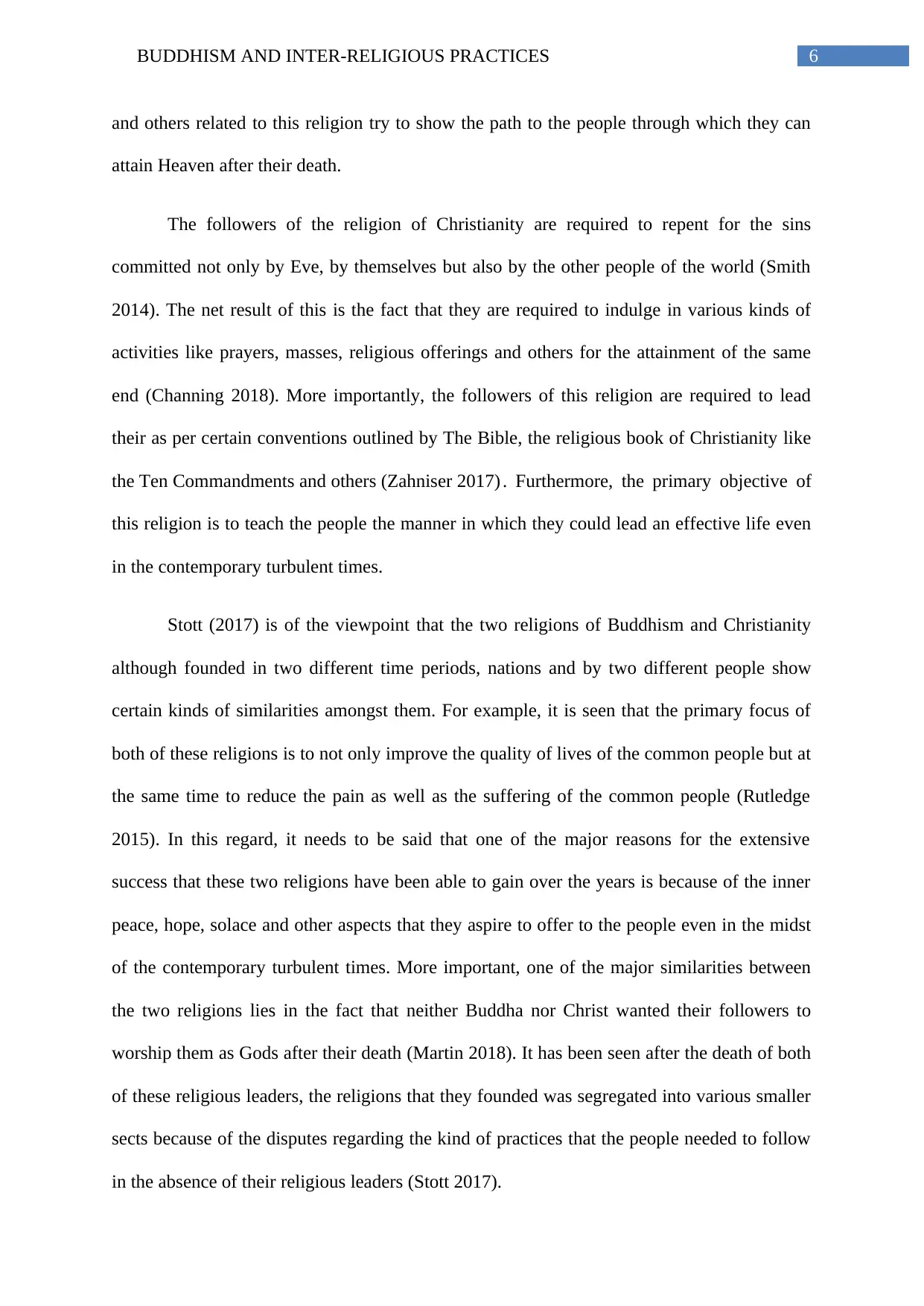
6BUDDHISM AND INTER-RELIGIOUS PRACTICES
and others related to this religion try to show the path to the people through which they can
attain Heaven after their death.
The followers of the religion of Christianity are required to repent for the sins
committed not only by Eve, by themselves but also by the other people of the world (Smith
2014). The net result of this is the fact that they are required to indulge in various kinds of
activities like prayers, masses, religious offerings and others for the attainment of the same
end (Channing 2018). More importantly, the followers of this religion are required to lead
their as per certain conventions outlined by The Bible, the religious book of Christianity like
the Ten Commandments and others (Zahniser 2017) . Furthermore, the primary objective of
this religion is to teach the people the manner in which they could lead an effective life even
in the contemporary turbulent times.
Stott (2017) is of the viewpoint that the two religions of Buddhism and Christianity
although founded in two different time periods, nations and by two different people show
certain kinds of similarities amongst them. For example, it is seen that the primary focus of
both of these religions is to not only improve the quality of lives of the common people but at
the same time to reduce the pain as well as the suffering of the common people (Rutledge
2015). In this regard, it needs to be said that one of the major reasons for the extensive
success that these two religions have been able to gain over the years is because of the inner
peace, hope, solace and other aspects that they aspire to offer to the people even in the midst
of the contemporary turbulent times. More important, one of the major similarities between
the two religions lies in the fact that neither Buddha nor Christ wanted their followers to
worship them as Gods after their death (Martin 2018). It has been seen after the death of both
of these religious leaders, the religions that they founded was segregated into various smaller
sects because of the disputes regarding the kind of practices that the people needed to follow
in the absence of their religious leaders (Stott 2017).
and others related to this religion try to show the path to the people through which they can
attain Heaven after their death.
The followers of the religion of Christianity are required to repent for the sins
committed not only by Eve, by themselves but also by the other people of the world (Smith
2014). The net result of this is the fact that they are required to indulge in various kinds of
activities like prayers, masses, religious offerings and others for the attainment of the same
end (Channing 2018). More importantly, the followers of this religion are required to lead
their as per certain conventions outlined by The Bible, the religious book of Christianity like
the Ten Commandments and others (Zahniser 2017) . Furthermore, the primary objective of
this religion is to teach the people the manner in which they could lead an effective life even
in the contemporary turbulent times.
Stott (2017) is of the viewpoint that the two religions of Buddhism and Christianity
although founded in two different time periods, nations and by two different people show
certain kinds of similarities amongst them. For example, it is seen that the primary focus of
both of these religions is to not only improve the quality of lives of the common people but at
the same time to reduce the pain as well as the suffering of the common people (Rutledge
2015). In this regard, it needs to be said that one of the major reasons for the extensive
success that these two religions have been able to gain over the years is because of the inner
peace, hope, solace and other aspects that they aspire to offer to the people even in the midst
of the contemporary turbulent times. More important, one of the major similarities between
the two religions lies in the fact that neither Buddha nor Christ wanted their followers to
worship them as Gods after their death (Martin 2018). It has been seen after the death of both
of these religious leaders, the religions that they founded was segregated into various smaller
sects because of the disputes regarding the kind of practices that the people needed to follow
in the absence of their religious leaders (Stott 2017).
Paraphrase This Document
Need a fresh take? Get an instant paraphrase of this document with our AI Paraphraser
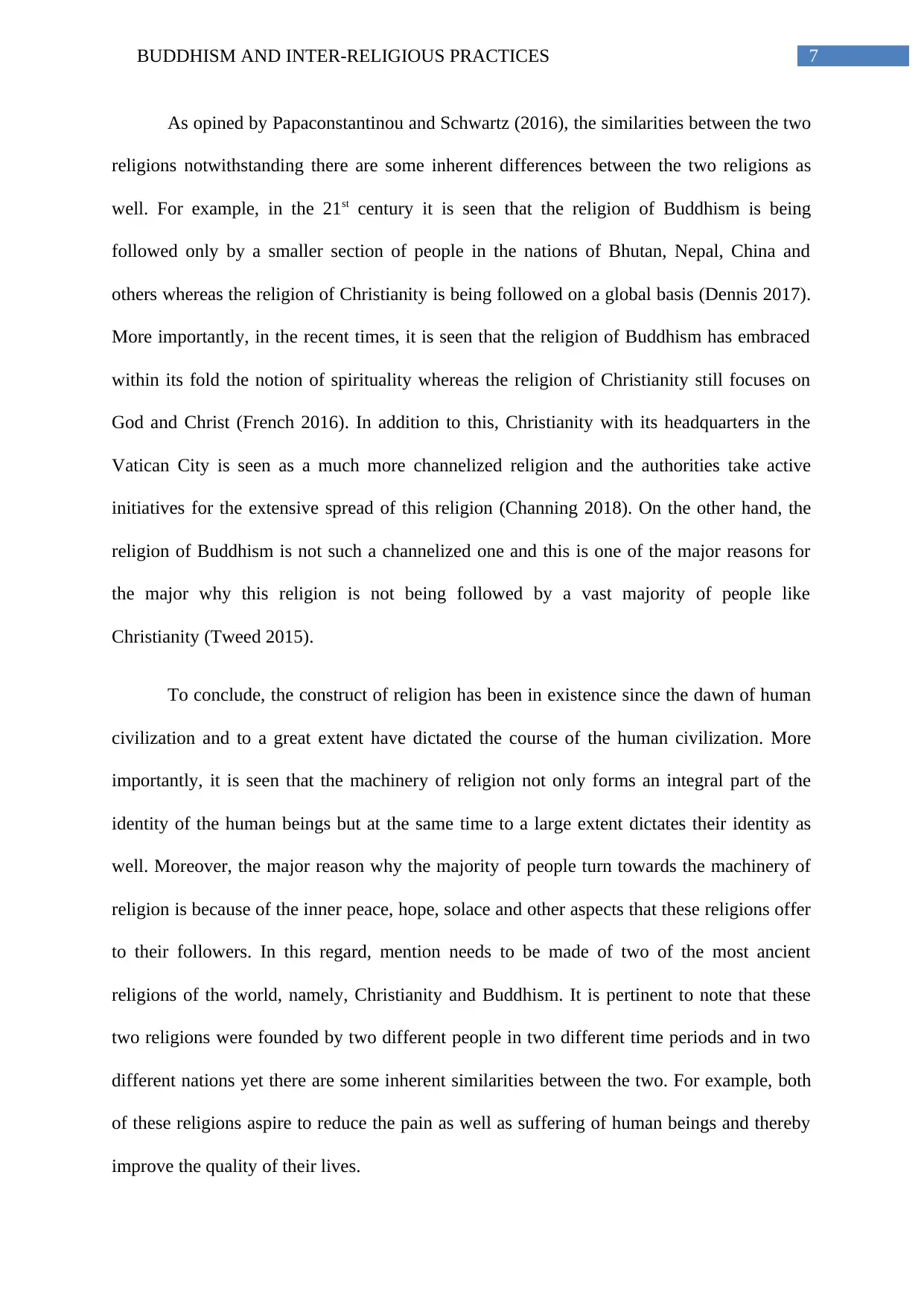
7BUDDHISM AND INTER-RELIGIOUS PRACTICES
As opined by Papaconstantinou and Schwartz (2016), the similarities between the two
religions notwithstanding there are some inherent differences between the two religions as
well. For example, in the 21st century it is seen that the religion of Buddhism is being
followed only by a smaller section of people in the nations of Bhutan, Nepal, China and
others whereas the religion of Christianity is being followed on a global basis (Dennis 2017).
More importantly, in the recent times, it is seen that the religion of Buddhism has embraced
within its fold the notion of spirituality whereas the religion of Christianity still focuses on
God and Christ (French 2016). In addition to this, Christianity with its headquarters in the
Vatican City is seen as a much more channelized religion and the authorities take active
initiatives for the extensive spread of this religion (Channing 2018). On the other hand, the
religion of Buddhism is not such a channelized one and this is one of the major reasons for
the major why this religion is not being followed by a vast majority of people like
Christianity (Tweed 2015).
To conclude, the construct of religion has been in existence since the dawn of human
civilization and to a great extent have dictated the course of the human civilization. More
importantly, it is seen that the machinery of religion not only forms an integral part of the
identity of the human beings but at the same time to a large extent dictates their identity as
well. Moreover, the major reason why the majority of people turn towards the machinery of
religion is because of the inner peace, hope, solace and other aspects that these religions offer
to their followers. In this regard, mention needs to be made of two of the most ancient
religions of the world, namely, Christianity and Buddhism. It is pertinent to note that these
two religions were founded by two different people in two different time periods and in two
different nations yet there are some inherent similarities between the two. For example, both
of these religions aspire to reduce the pain as well as suffering of human beings and thereby
improve the quality of their lives.
As opined by Papaconstantinou and Schwartz (2016), the similarities between the two
religions notwithstanding there are some inherent differences between the two religions as
well. For example, in the 21st century it is seen that the religion of Buddhism is being
followed only by a smaller section of people in the nations of Bhutan, Nepal, China and
others whereas the religion of Christianity is being followed on a global basis (Dennis 2017).
More importantly, in the recent times, it is seen that the religion of Buddhism has embraced
within its fold the notion of spirituality whereas the religion of Christianity still focuses on
God and Christ (French 2016). In addition to this, Christianity with its headquarters in the
Vatican City is seen as a much more channelized religion and the authorities take active
initiatives for the extensive spread of this religion (Channing 2018). On the other hand, the
religion of Buddhism is not such a channelized one and this is one of the major reasons for
the major why this religion is not being followed by a vast majority of people like
Christianity (Tweed 2015).
To conclude, the construct of religion has been in existence since the dawn of human
civilization and to a great extent have dictated the course of the human civilization. More
importantly, it is seen that the machinery of religion not only forms an integral part of the
identity of the human beings but at the same time to a large extent dictates their identity as
well. Moreover, the major reason why the majority of people turn towards the machinery of
religion is because of the inner peace, hope, solace and other aspects that these religions offer
to their followers. In this regard, mention needs to be made of two of the most ancient
religions of the world, namely, Christianity and Buddhism. It is pertinent to note that these
two religions were founded by two different people in two different time periods and in two
different nations yet there are some inherent similarities between the two. For example, both
of these religions aspire to reduce the pain as well as suffering of human beings and thereby
improve the quality of their lives.
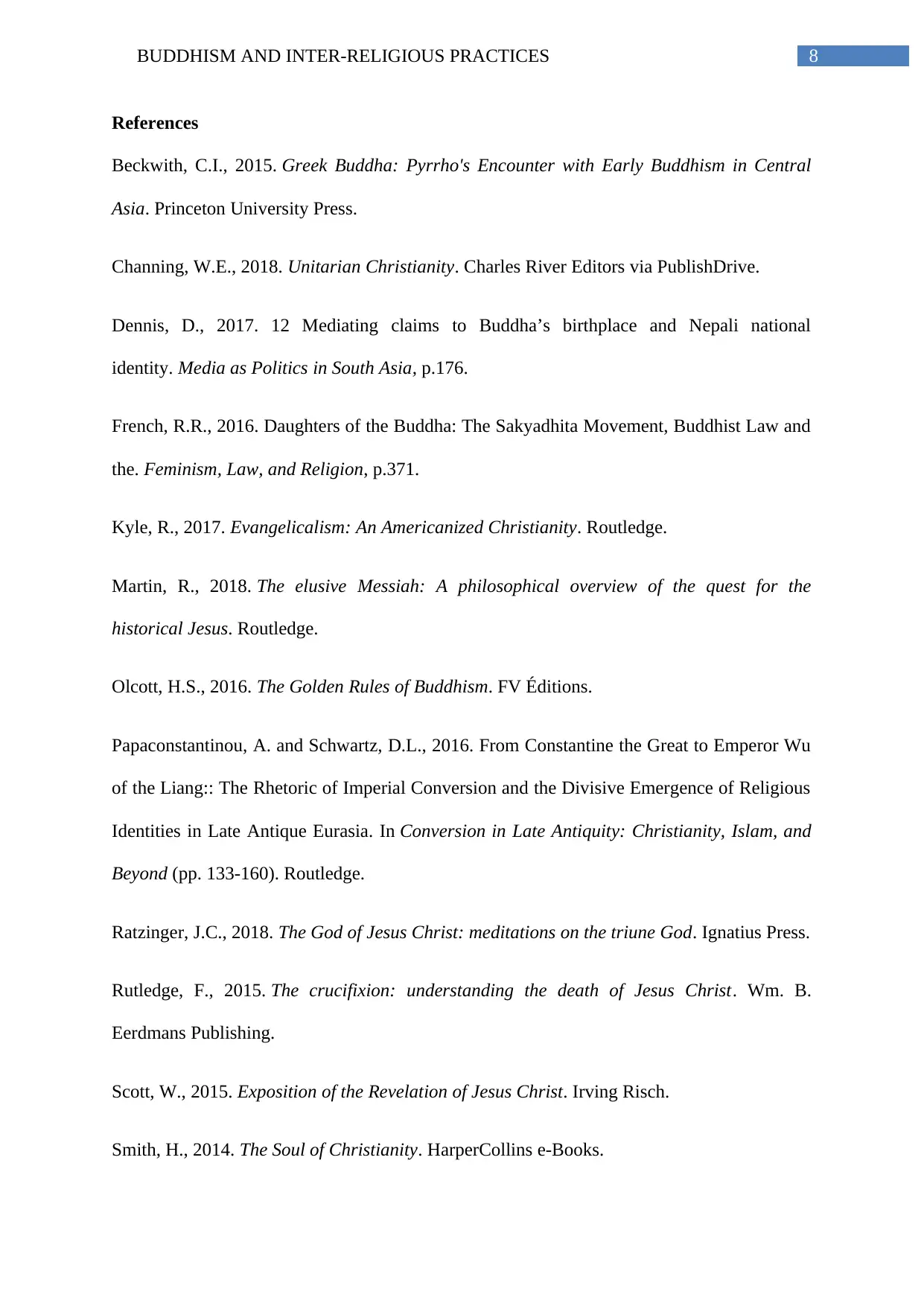
8BUDDHISM AND INTER-RELIGIOUS PRACTICES
References
Beckwith, C.I., 2015. Greek Buddha: Pyrrho's Encounter with Early Buddhism in Central
Asia. Princeton University Press.
Channing, W.E., 2018. Unitarian Christianity. Charles River Editors via PublishDrive.
Dennis, D., 2017. 12 Mediating claims to Buddha’s birthplace and Nepali national
identity. Media as Politics in South Asia, p.176.
French, R.R., 2016. Daughters of the Buddha: The Sakyadhita Movement, Buddhist Law and
the. Feminism, Law, and Religion, p.371.
Kyle, R., 2017. Evangelicalism: An Americanized Christianity. Routledge.
Martin, R., 2018. The elusive Messiah: A philosophical overview of the quest for the
historical Jesus. Routledge.
Olcott, H.S., 2016. The Golden Rules of Buddhism. FV Éditions.
Papaconstantinou, A. and Schwartz, D.L., 2016. From Constantine the Great to Emperor Wu
of the Liang:: The Rhetoric of Imperial Conversion and the Divisive Emergence of Religious
Identities in Late Antique Eurasia. In Conversion in Late Antiquity: Christianity, Islam, and
Beyond (pp. 133-160). Routledge.
Ratzinger, J.C., 2018. The God of Jesus Christ: meditations on the triune God. Ignatius Press.
Rutledge, F., 2015. The crucifixion: understanding the death of Jesus Christ. Wm. B.
Eerdmans Publishing.
Scott, W., 2015. Exposition of the Revelation of Jesus Christ. Irving Risch.
Smith, H., 2014. The Soul of Christianity. HarperCollins e-Books.
References
Beckwith, C.I., 2015. Greek Buddha: Pyrrho's Encounter with Early Buddhism in Central
Asia. Princeton University Press.
Channing, W.E., 2018. Unitarian Christianity. Charles River Editors via PublishDrive.
Dennis, D., 2017. 12 Mediating claims to Buddha’s birthplace and Nepali national
identity. Media as Politics in South Asia, p.176.
French, R.R., 2016. Daughters of the Buddha: The Sakyadhita Movement, Buddhist Law and
the. Feminism, Law, and Religion, p.371.
Kyle, R., 2017. Evangelicalism: An Americanized Christianity. Routledge.
Martin, R., 2018. The elusive Messiah: A philosophical overview of the quest for the
historical Jesus. Routledge.
Olcott, H.S., 2016. The Golden Rules of Buddhism. FV Éditions.
Papaconstantinou, A. and Schwartz, D.L., 2016. From Constantine the Great to Emperor Wu
of the Liang:: The Rhetoric of Imperial Conversion and the Divisive Emergence of Religious
Identities in Late Antique Eurasia. In Conversion in Late Antiquity: Christianity, Islam, and
Beyond (pp. 133-160). Routledge.
Ratzinger, J.C., 2018. The God of Jesus Christ: meditations on the triune God. Ignatius Press.
Rutledge, F., 2015. The crucifixion: understanding the death of Jesus Christ. Wm. B.
Eerdmans Publishing.
Scott, W., 2015. Exposition of the Revelation of Jesus Christ. Irving Risch.
Smith, H., 2014. The Soul of Christianity. HarperCollins e-Books.
⊘ This is a preview!⊘
Do you want full access?
Subscribe today to unlock all pages.

Trusted by 1+ million students worldwide
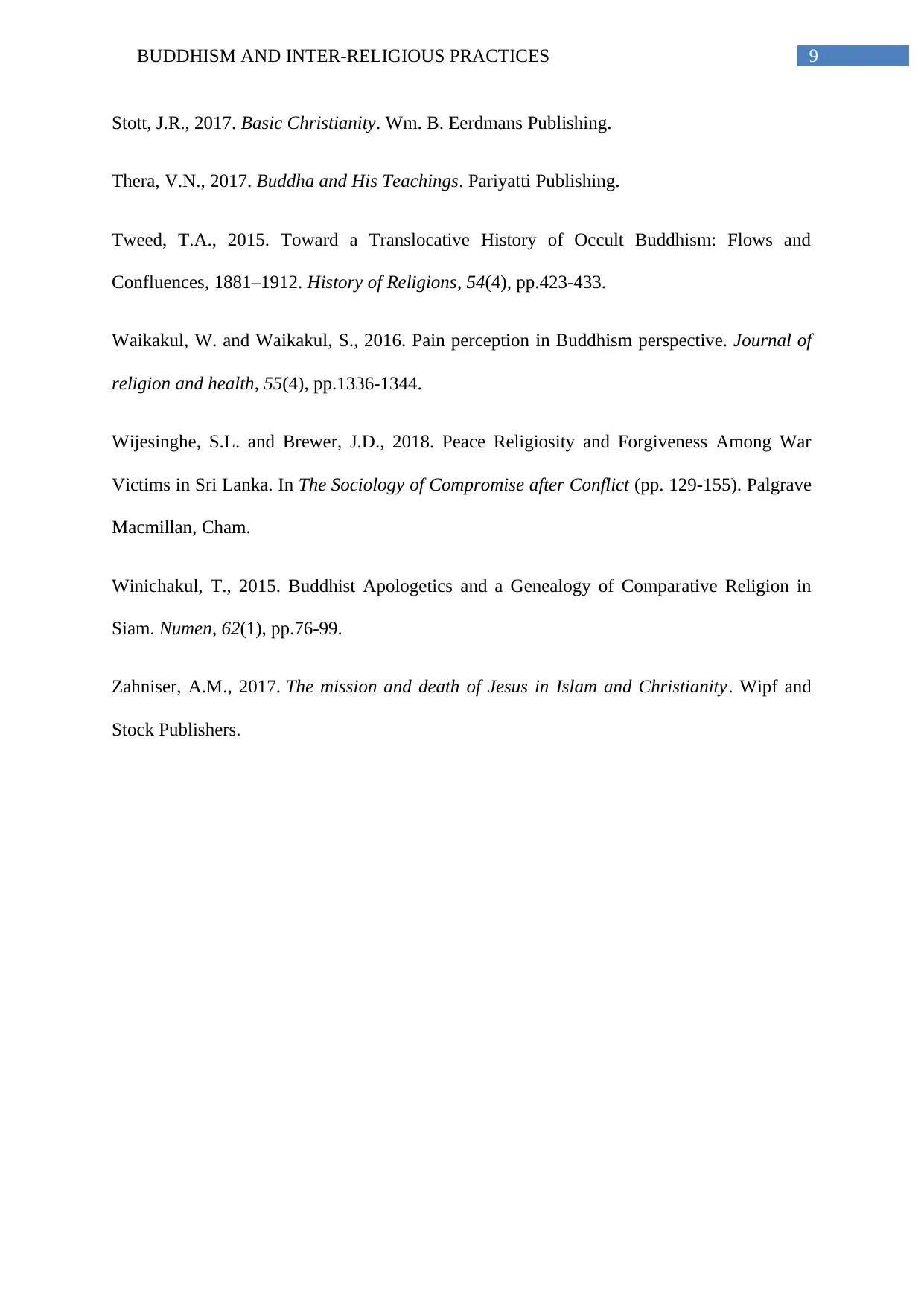
9BUDDHISM AND INTER-RELIGIOUS PRACTICES
Stott, J.R., 2017. Basic Christianity. Wm. B. Eerdmans Publishing.
Thera, V.N., 2017. Buddha and His Teachings. Pariyatti Publishing.
Tweed, T.A., 2015. Toward a Translocative History of Occult Buddhism: Flows and
Confluences, 1881–1912. History of Religions, 54(4), pp.423-433.
Waikakul, W. and Waikakul, S., 2016. Pain perception in Buddhism perspective. Journal of
religion and health, 55(4), pp.1336-1344.
Wijesinghe, S.L. and Brewer, J.D., 2018. Peace Religiosity and Forgiveness Among War
Victims in Sri Lanka. In The Sociology of Compromise after Conflict (pp. 129-155). Palgrave
Macmillan, Cham.
Winichakul, T., 2015. Buddhist Apologetics and a Genealogy of Comparative Religion in
Siam. Numen, 62(1), pp.76-99.
Zahniser, A.M., 2017. The mission and death of Jesus in Islam and Christianity. Wipf and
Stock Publishers.
Stott, J.R., 2017. Basic Christianity. Wm. B. Eerdmans Publishing.
Thera, V.N., 2017. Buddha and His Teachings. Pariyatti Publishing.
Tweed, T.A., 2015. Toward a Translocative History of Occult Buddhism: Flows and
Confluences, 1881–1912. History of Religions, 54(4), pp.423-433.
Waikakul, W. and Waikakul, S., 2016. Pain perception in Buddhism perspective. Journal of
religion and health, 55(4), pp.1336-1344.
Wijesinghe, S.L. and Brewer, J.D., 2018. Peace Religiosity and Forgiveness Among War
Victims in Sri Lanka. In The Sociology of Compromise after Conflict (pp. 129-155). Palgrave
Macmillan, Cham.
Winichakul, T., 2015. Buddhist Apologetics and a Genealogy of Comparative Religion in
Siam. Numen, 62(1), pp.76-99.
Zahniser, A.M., 2017. The mission and death of Jesus in Islam and Christianity. Wipf and
Stock Publishers.
1 out of 10
Related Documents
Your All-in-One AI-Powered Toolkit for Academic Success.
+13062052269
info@desklib.com
Available 24*7 on WhatsApp / Email
![[object Object]](/_next/static/media/star-bottom.7253800d.svg)
Unlock your academic potential
Copyright © 2020–2025 A2Z Services. All Rights Reserved. Developed and managed by ZUCOL.




